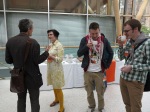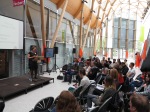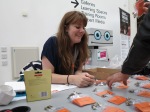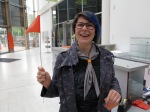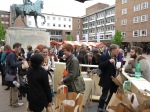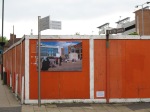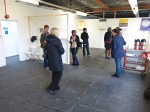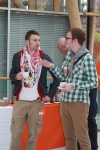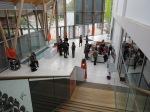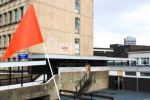ARC Symposium: The Artist Behind The City
A day of discussion and discovery in Coventry, UK
17th May 2013
Prelude: 5 cultural experiences in Coventry city
The symposium represents the culmination of a 12-month period of artistic activity where five cultural producers (artists, curators, architects etc) were commissioned to work in Coventry through Artspace. The organisation who are based in the city are focused on cultivating a profile of an ‘engaging visual art practice.’ They are an umbrella for a range of activities including provision of artists’ studios, educational programming and offering people in the city opportunities to be involved in ‘art in the city’.
The five commissions were HIJACK (Nikki Pugh), GENERATE (Miriam Craik-Horan), TRANSFORM (Rob Hewitt, Redhawk Logistica), UNITE (Anne Forgan) and PIONEER (Andrew T Cross).
The symposium was a chance to showcase the ARC programme, Artist Research Commissions, as well as to explore the potential for new developments with international artists and local communities in Coventry for 2014. The metaphor of the Roman Janus double head that can simultaneously see the past and the future seems a fitting one to establish an anchor point for where Artspace are currently situated. Laura Elliott the Director of Artspace explained that after an intense period of activity, the organization now wanted to have a period of reflection to inform how their future programme would develop. This seems to be a logical and critical part of an organisation’s work but one that is not perhaps always exploited enough. There is a continual cycle of activities that an organization must engage in to keep surviving but perhaps the point of reflection is one aspect that may be overlooked or seen as time consuming? The symposium marked the beginning of that process for Artspace.
In the Middle of the Midlands – Identifiying Coventry’s Cultural Offer
Coventry is underpinned by a rich history, it has remodeled itself post war but in 2013, where does its cultural life emerge and filter into making a real difference to not just its visitors but also its local population? Coventry Council stated that;
“The city’s cultural offer plays a key part in the regeneration of Coventry, and we want to make sure our cultural attractions have a viable future, are as efficient as possible and can market themselves effectively to local, regional and national audiences so they can grow and succeed in the future.
(Coventry City Council, January 22nd 2013)
The heritage of the city is without doubt, of importance and value, not just at a local level but at a national and international one too. To keep this vibrant & current though requires a cultural strategy that can be interwoven and stimulated by contemporary cultural interventions. The ambition of the council is towards a varied audience but it appears to be focused upon those existing cultural sites.
The ARC symposium is addressing the forgotten aspects of a city, where cultural conversations are not readily forged. It is also aiming to influence these overarching strategies that are being developed by the local authority, by ‘..informing cultural, artistic and city agendas..’
The aims behind the symposium were to;
-Examine international contemporary art practices
-Introduce the ARC programme and artists
-Explore artists’ spaces/locations for making and showing work
-Discuss whether artists in Coventry can play a larger part in the forming the city’ destination offer
(ARC Sympoisum: The artist behind the city)
Enter stage left; Artists Lee Simmons, Peter Kennard and Jacques Nimki
Three artists, independent of the ARC programme, were invited to talk about their practice at the symposium, to bring an outside perspective to the proceedings and to showcase a wide-ranging portfolio of activity when engaging in participatory projects. It was perhaps notable that the three artists were all based in London or the South East where ambitious work is more readily received due to its cultural landscape and investment in art. They may be living or working in an area that perhaps offers more opportunities but it is also highly competitive. The artists were not solely operating in that geographical locale either but were creating projects in national and international settings.
It was clear that despite being in a fertile area of creative activity, the artists had all faced obstacles of one kind or another and had to be resourceful in how they operated as artists.
Lee Simmons discussed how she had been harangued by a group of local people in Surrey when she had painted a section of a white cliff, purple (even with full permissions). This had led to her questioning her motives and ways of working, leading to periods of anonymity with some subsequent projects. Similarly Peter Kennard and Jacques Nimki had tales about other tricky aspects of socially engaged projects with the logistics of making large-scale prints or creating a living ‘weed’ meadow.
The three artists were able to offer a broad spectrum of how they work with communities, which was stimulated by their inventive ideas and projects. What often came across from each artist was a willingness to be open and to not impose their ideas about how participants should engage creatively in a rigid way. Instead the participatory work they conveyed seemed to emerge gradually from a starting point of their own projects.
What could the creative community in Coventry learn from these presentations and how might it influence them? The response from the audience was enthusiastic but a reappraisal of the spectrum of participatory arts in the city will inevitably take time to change.
All of these presentations dislodged any of the negative associations that can be linked to ‘community arts’ where unambitious projects result in disappointing outcomes. It was inspiring listening to projects that were imaginative and not afraid to introduce people to challenging propositions and ideas.
Interval (Half-Time)
At a mid point in the symposium an extraordinary flurry of activity began which involved orange flags and grey neckerchiefs with orange t/woggles. Attendees were whisked off to Broadgate where a packed lunch was being distributed (from the PIONEER project) and then herded into small groups to visit sites where the artists from the programme were positioned on hand to talk about their work. There were also additional pit stops at other art venues in the city such as the Meter Room and Roots Gallery. Guiding us were volunteers (mine were two young fine art students from Coventry University) attired in the scarves with the flags so that we would not get lost. We were also handed a large map too with more activities on it than you could throw a stick at. It did become slightly chaotic at some point with groups getting a bit mixed up but it was all part of the experience.
I opted for the tree climbing and Artspace tour. I was not dressed appropriately for the tree climbing organized by the artist Anne Forgan for her Unite project. I was truly vexed by my decision to wear a skirt that morning. No matter, it was fun to watch those who signed up for the mini adventure. I then went into Artspace and was warmly welcomed by artists there including Elena Cassidy-Smith who had been an artist in residence there looking at ideas about servitude. Elena kindly pointed me in the direction of the cellars and the studios, which were fascinating. It felt as though the whole building was genuinely connected to the city and not aloof from it. Whilst at Artspace, I met Nikki Pugh of the HIJACK project and she talked to me in depth about her project.
A new group was then established to go to the Meter Room as my original group had splintered. We arrived at a post war urban building, typical of the redeveloped architecture of Coventry, where Meter Room is situated. There we saw TRANSFORM the project by Rob Hewitt which was about the artist’s correspondence with the local council about the distribution of flyers and subsequent brand logos from prominent retail businesses in Coventry like Ikea and Primark, being altered by Hewitt and redistributed. I think that is the gist of the project. I found it hard to source information about it and like a rum detective, I have pieced together a version for myself.
I then left my group and ventured off solo to the Herbert Gallery to see Peter Kennard’s work in the group show Caught In The Crossfire. Outside the entrance of the gallery space were some examples of placards made in a workshop that KennardPhilips had run.
This middle part of the symposium was ambitious and fun. It allowed for a very different kind of experience, one that was more hands on and about action rather than being static. The moments of human mayhem such as when the packed lunch was being distributed and a group of elderly pensioners were trying to haul off a stash of food for themselves amidst the symposium delegates seemed to add to the moment and underline how unpredictable it can be doing participatory work.
My one frustration at this point was that it was hard to unpack the five projects, which were part of the ARC programme. I found three artists at different sites but often they were engaged in discussion and there was a tricky choice of balancing the experience of hearing directly from the artists or pressing on to visit the other venues in the city.
I felt that it might have been beneficial if the artists could have given a brief formal presentation about their involvement perhaps at the beginning of the day before the three invited guest artists. Questions such as what effect these five residencies had on the communities they engaged with or how they had impacted and made a difference to those people involved would have contextualized the five projects.
Time was obviously of the essence and the programme did over run as it was but nevertheless, I felt it was a valuable opportunity missed. For the audience it would have provided some continuity between the activity in Coventry and things happening beyond the margins of the city.
But hooray for flags and packed lunches!
The Grand Finale – the mutterings and chatterings of Coventry’s culturals’ and others
Returning to the symposium’s base at the Herbert Gallery, delegates found a circle of chairs in anticipation of the third part of the day, where a discussion was planned to explore if artists in Coventry could ‘..play a larger part in developing the city’s destination offer.’
The inner circle was made up of Laura Elliott from Artspace, the three independent artists, Simmons, Kennard and Nimki with other notable guests such as Wendy Law from TPWM and Caroline Foxhall the Chair of Artspace’s Board of Trustees.
From there concentric rings of chairs made up a range of the delegates including local artists and the five programmed artists.
Laura Elliott led the discussion engaging in the subject of Coventry as a destination, carefully laying out an interesting discursive opportunity to explore the subject but the discussion was suddenly plundered into the thorny subject of how language is used by artists/curators/creative producers etc to communicate to the layperson.
This seemed to raise the blood pressures of some people in the audience who saw the language as a veil for mystifying the art world. The three artists initially responded with a kind of crowd-pleasing response having been thrust into a difficult situation.
The tension seemed to relax a little when the issue was teased out more and it was compared to any specialist area having a particularized language such as nuclear physics, for example.
Rob Hewitt from Redhawk Logistica suggested that asking someone neutral to interpret your work is a useful tool.
This was the first nub of irritation which began to emerge and it became apparent that a minority of locally based artists from Coventry were upset, baffled and hostile towards the mechanisms of cultural structures including funding, galleries and international artists. They seemed to view the situation as a reduction of opportunities for them in the city as opposed to opening up a more enriching dialogue. I wasn’t convinced that this was a consensus held amongst all of those who were based in the area however, because it was voiced by just one or two repetitive voices. This seemed to restrict the opportunity for others to speak who were perhaps less confident or vocal.
Some of the initial points for discussion were re-visited with the intervention of Miriam Craik-Horan who had delivered the GENERATE programme. Miriam talked about her work with a group of A Level students and she identified how she had imparted a cultural capital to the group. Through language and action she found a different method of encouraging new connections with culture in Coventry. It was key for her, not to dogmatically design workshops that purely mimicked her own work, for the students. Perhaps the lack of tangibility for some of the audience was hard to grasp? In a discussion about the artist in the city, I could sense that some may have been wondering where the ‘physical’ art existed in the five commissions.
The question of what art in community settings means revealed a void between those driving on with ambitious programming and responses and those who were quite challenged by these.
As the discussion developed there were examples of how the current crisis in funding is affecting a creative community. Artists are unsure about this transition from regular reliance on funded projects to a landscape, which looks increasingly variable and uncertain. ‘Artists need to look to themselves’ was one response and Wendy Law from TPWM sited the need for artists to ‘make it what you will’. In other words, artists have to wise up and understand that they must respond creatively to the current situation.
This led neatly back to the localized situation in Coventry where despite the lack of funding, some participants had recognised the need for a provision of artistic input into communities. A lack of expertise in schools for example, meant that artists were important figures in retaining creative opportunities.
The map, which Artspace had drawn up for the event, had sparked a sense of how rich the culture is in the city, with many small independent groups operating alongside the more established ones. Although there is often a ‘running down of Coventry’ it appeared that this was unfounded. Most participants agreed that collectivity was vital to strengthening the cultural offer for the city. It was suggested that a physical map of cultural hotspots in Coventry could be a very useful tool for visitors.
Within that identification of cultural places, new social media was mentioned as a useful tool to build upon networking opportunities. I reflected upon the Whistable Biennale who have made an app to enable their visitors to navigate the different locations of the festival. This was highly successful, providing practical information like maps as well as profiles of projects and artists involved, all accessed on a mobile phone.
There was an interesting rolling conversation about the role of artists in the city, about whether the public wants to be engaged and influenced by art, how much artists were contributing to the city, about artists putting themselves into public spaces and how that was received (it was more healthy than going to an art gallery, stated Hewitt) and the difficulties and resistance to art in the public arena.
The public can be hard to please; delighted with an art project one minute and in uproar at an uncompromising project in another. There are small conversations that can happen which will have ripples in communities, where the atmosphere is conducive to creating a dialogue. A project gains a foothold in the public’s consciousness. Equally there can be projects, which do not find acceptance with a public audience.
Laura Elliott talked about the continuing dialogue with Coventry’s communities through a number of outlets including the local radio. This had begun to bear fruit as the radio station had become familiar with past projects that Artspace had done. Whilst this might not be seen as significant, it felt crucial to the development of the interrelationship of artists and communities in the city. As Jacques Nimki said, it takes a long time to establish an audience and patience is needed.
Although the discussion became diverted at times from the original points about the role of artists in the city to the cultural offer, it did reveal the logistics of how a cultural community operates. Many of the issues were at the grassroots of the desire to be part of the cultural offer.
During the conversations about art language or survival of artists, issues rose up that were to be of note; firstly the city has a passionate collective of creative participants who are keen to develop cultural activities, secondly, there was a consensus that working in a more collective way would strengthen the cultural offer and thirdly, despite a focus by the local authority on the existing major attractions such as the Cathedral or the Lunt Roman Fort, alternative organsations are mushrooming and forging diverse cultural experiences.
There is also a tanker that needs to change course, in the guise of some artists who want to restrict opportunities to locally based creatives only. Whilst there is a vital role for them in the city, it is perhaps short sited to limit the ambition of creative activity to purely the city walls. Curators and Producers who are programming artists from diverse backgrounds will appreciate the exciting possibilities that this can bring to a place. This will in turn feed back into the vitality of the city and generate interesting ideas offering responses to the city that can be fresh and come from differing perspectives.
Reflection
Artspace’s remit to extend the cultural experience into these hidden parts of the city, to broker relations between local, national and international artists, cultural partners and community groups and to play a larger part in the attraction of visiting Coventry, is critical. Artspace are not just reinforcing the cultural experiences that already exist but are tapping into communities that could easily be erased out of the cultural landscape. In fact, the ARC programme has displayed a sort of archeological unearthing of forgotten treasures, which with careful programming and inspirational artists, can and did enrich further, this cultural offer. It is something, which is overlooked by the local authority that is focused on the historical legacy of Coventry and how that can draw in visitors and help to regenerate the area. Although seeing the bigger picture is part of the authorities remit the work at a grass roots level is equally critical. The emerging spaces such as the Meter Room, Lanchester Gallery Projects along with artist’s studios at Artspace for example, can build a portfolio of cultural activity that are blossoming in unexpected places.
References
ARC Symposium: The artist behind the city, May 17th 2013, Artspace, Coventry.
Artspace ARC Programme: Updates about the Artspace Research Commission programme {online} available at
http://www.arcprogramme.co.uk/pages/arc-symposium
Accessed May 2013
Coventry City Council 22/01/13, New Cultural Trust Chief Announced {online} available at http://www.coventry.gov.uk/news/article/686/new_cultural_trust_chief_executive_announced Accessed May 2013
Anna Falcini 2013

